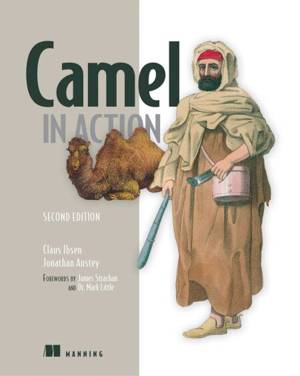
- Afhalen na 1 uur in een winkel met voorraad
- Gratis thuislevering in België vanaf € 30
- Ruim aanbod met 7 miljoen producten
- Afhalen na 1 uur in een winkel met voorraad
- Gratis thuislevering in België vanaf € 30
- Ruim aanbod met 7 miljoen producten
Zoeken
Omschrijving
Summary
Camel in Action, Second Edition is the most complete Camel book on the market. Written by core developers of Camel and the authors of the highly acclaimed first edition, this book distills their experience and practical insights so that you can tackle integration tasks like a pro.
Forewords by James Strachan and Dr. Mark Little
Purchase of the print book includes a free eBook in PDF, Kindle, and ePub formats from Manning Publications.
About the Technology
Apache Camel is a Java framework that implements enterprise integration patterns (EIPs) and comes with over 200 adapters to third-party systems. A concise DSL lets you build integration logic into your app with just a few lines of Java or XML. By using Camel, you benefit from the testing and experience of a large and vibrant open source community.
About the Book
Camel in Action, Second Edition is the definitive guide to the Camel framework. It starts with core concepts like sending, receiving, routing, and transforming data. It then goes in depth on many topics such as how to develop, debug, test, deal with errors, secure, scale, cluster, deploy, and monitor your Camel applications. The book also discusses how to run Camel with microservices, reactive systems, containers, and in the cloud.
What's Inside
Coverage of all relevant EIPs Camel microservices with Spring Boot Camel on Docker and Kubernetes Error handling, testing, security, clustering, monitoring, and deployment Hundreds of examples in Java and XML
About the Reader
Readers should be familiar with Java. This book is accessible to beginners and invaluable to experts.
About the Author
Claus Ibsen is a senior principal engineer working for Red Hat specializing in cloud and integration. He has worked on Apache Camel for the last nine years where he heads the project. Claus lives in Denmark.
Jonathan Anstey is an engineering manager at Red Hat and a core Camel contributor. He lives in Newfoundland, Canada.
Table of Contents
Part 1 - First steps Meeting Camel Routing with Camel Part 2 - Core Camel Transforming data with Camel Using beans with Camel Enterprise integration patterns Using components Part 3 - Developing and testing Microservices Developing Camel projects Testing RESTful web services Part 4 - Going further with Camel Error handling Transactions and idempotency Parallel processing Securing Camel Part 5 - Running and managing Camel Running and deploying Camel Management and monitoring Part 6 - Out in the wild Clustering Microservices with Docker and Kubernetes Camel tooling
Bonus online chapters
Available at https://www.manning.com/books/camel-in-action-second-edition and in electronic versions of this book:
Reactive Camel Camel and the IoT by Henryk Konsek
Camel in Action, Second Edition is the most complete Camel book on the market. Written by core developers of Camel and the authors of the highly acclaimed first edition, this book distills their experience and practical insights so that you can tackle integration tasks like a pro.
Forewords by James Strachan and Dr. Mark Little
Purchase of the print book includes a free eBook in PDF, Kindle, and ePub formats from Manning Publications.
About the Technology
Apache Camel is a Java framework that implements enterprise integration patterns (EIPs) and comes with over 200 adapters to third-party systems. A concise DSL lets you build integration logic into your app with just a few lines of Java or XML. By using Camel, you benefit from the testing and experience of a large and vibrant open source community.
About the Book
Camel in Action, Second Edition is the definitive guide to the Camel framework. It starts with core concepts like sending, receiving, routing, and transforming data. It then goes in depth on many topics such as how to develop, debug, test, deal with errors, secure, scale, cluster, deploy, and monitor your Camel applications. The book also discusses how to run Camel with microservices, reactive systems, containers, and in the cloud.
What's Inside
Coverage of all relevant EIPs Camel microservices with Spring Boot Camel on Docker and Kubernetes Error handling, testing, security, clustering, monitoring, and deployment Hundreds of examples in Java and XML
About the Reader
Readers should be familiar with Java. This book is accessible to beginners and invaluable to experts.
About the Author
Claus Ibsen is a senior principal engineer working for Red Hat specializing in cloud and integration. He has worked on Apache Camel for the last nine years where he heads the project. Claus lives in Denmark.
Jonathan Anstey is an engineering manager at Red Hat and a core Camel contributor. He lives in Newfoundland, Canada.
Table of Contents
Part 1 - First steps Meeting Camel Routing with Camel Part 2 - Core Camel Transforming data with Camel Using beans with Camel Enterprise integration patterns Using components Part 3 - Developing and testing Microservices Developing Camel projects Testing RESTful web services Part 4 - Going further with Camel Error handling Transactions and idempotency Parallel processing Securing Camel Part 5 - Running and managing Camel Running and deploying Camel Management and monitoring Part 6 - Out in the wild Clustering Microservices with Docker and Kubernetes Camel tooling
Bonus online chapters
Available at https://www.manning.com/books/camel-in-action-second-edition and in electronic versions of this book:
Reactive Camel Camel and the IoT by Henryk Konsek
Specificaties
Betrokkenen
- Auteur(s):
- Uitgeverij:
Inhoud
- Aantal bladzijden:
- 912
- Taal:
- Engels
Eigenschappen
- Productcode (EAN):
- 9781638352808
- Verschijningsdatum:
- 1/02/2018
- Uitvoering:
- E-book
- Beveiligd met:
- Adobe DRM
- Formaat:
- ePub

Alleen bij Standaard Boekhandel
+ 59 punten op je klantenkaart van Standaard Boekhandel
Beoordelingen
We publiceren alleen reviews die voldoen aan de voorwaarden voor reviews. Bekijk onze voorwaarden voor reviews.











